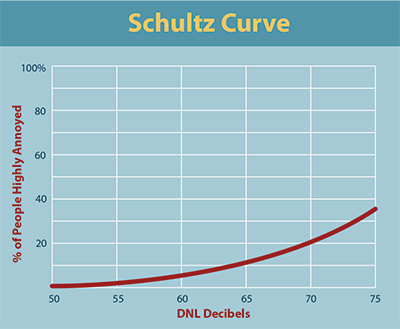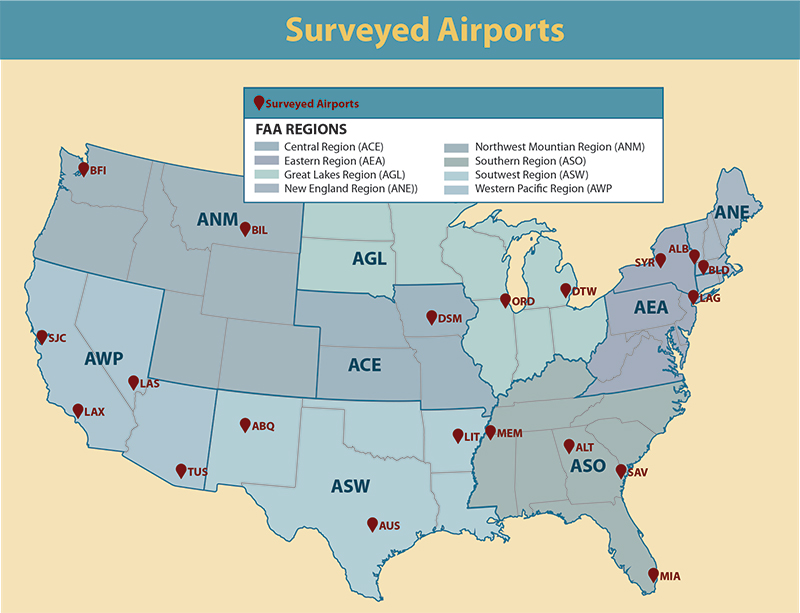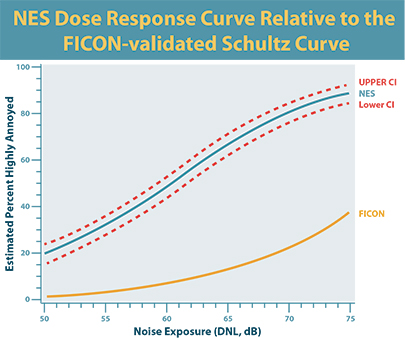Insights: FAA’s Neighborhood Environmental Survey Sheds New Light on Annoyance
On January 13, 2021, the Federal Aviation Administration (FAA) made available the Neighborhood Environmental Survey (NES) via a Federal Register notification, Overview of FAA Aircraft Noise Policy and Research Efforts: Request for Input on Research Activities To Inform Aircraft Noise Policy. Many in the airport industry have been anxiously awaiting the NES, the release of which had been postponed many times over the last few years. The fundamental purpose of the NES was to inform FAA noise policy by reevaluating community annoyance relative to experienced noise exposure through a large-scale survey effort around 20 U.S. airports.
Background and the Schultz Curve

While the Federal Register notice summarizes numerous completed, ongoing, and future research activities, the topic that has garnered the most interest is the NES and in particular how the findings compare to the longstanding research that shaped existing FAA noise policy. The Schultz Curve, developed from social surveys conducted in the 1960s and 1970s for a variety of transportation noise sources has served as the foundation of FAA noise policy for more than four decades. It set the threshold of significance for aircraft-generated noise at the Day-Night Average Sound Level (DNL) of 65 decibels (dB). The Federal Interagency Commission on Noise (FICON) re-validated the Schultz Curve in 1992.
Land uses that include single and multi-family residential, educational facilities, hospitals and nursing homes, and houses of worship have been considered incompatible with noise levels of DNL 65 dB and greater. 14 CFR Part 150, Airport Noise Compatibility Planning, was published in 1984 and established the framework for developing airport noise exposure maps and evaluating the compatibility of land uses with noise levels. The content of Table 1, Land Use Compatibility with Yearly Day-Night Average Sound Levels, in Appendix A of 14 CFR Part 150 is based upon the Schultz Curve and has been used by airports in hundreds of noise studies and other environmental evaluations of airport development.
Study Process and Findings
FAA’s study team started the NES in 2015 with a set of 95 airports based upon criteria that included at least 100 annual jet operations, location within the contiguous U.S. and population located within noise contours of 60 dB and 65dB. From this set, they selected 20 U.S. airports through “balanced sampling” where surveys would be distributed in waves to groups of residents with the intent to gather 10,000 total survey responses. The process was also designed to include follow-up telephone surveys with a subset of those that returned the mailed surveys. At least one airport in each of FAA’s eight regions within the contiguous U.S. was included and airports ranged from General Aviation (GA) airports up to and including large-hub primary airports.

More than 26,000 surveys were mailed in 2015 and 2016 to residential addresses near the 20 airports and a total of 10,007 questionnaires were returned—a 40% response rate. To avoid potential bias, the survey instrument was designed with a wide range of questions intended to gauge annoyance with a variety of issues that included, but were not specific to aircraft noise, including surface traffic, litter, crime, etc. In fact, there was only one question in the survey focused on aircraft noise. In this question, participants were asked to rank how any of the topics, including aircraft noise, “bother, disturb or annoy” the individual, with over five choices ranging from “Not at all” to “Extremely”. The follow-up telephone surveys included much greater detailed questions about annoyance from aircraft noise. More than 1,900 phone surveys were completed.

FAA’s study team was ultimately focused on comparing dose-response curves derived from the survey data with the Schultz Curve to help inform future FAA decisions on national noise policy matters. A dose-response curve charts an estimated percent of highly annoyed people against DNL levels in dB. Curves were developed for each of the 20 airports and then combined to create a national dose-response curve based upon the results of the surveys. The NES findings suggest that significant changes have occurred in the reaction of individuals in the U.S. over the last five decades and that as many as 20% of the population is highly annoyed at a noise exposure of DNL 50 dB. Where the FICON validation of the Schulz Curve indicated 12.3% of the population was highly annoyed at DNL 65 dB, the NES findings indicate greater than 60% of the population is highly annoyed at that same noise exposure.
The NES is not intended, on its own, to shape decision making for future FAA noise policy. Rather, as described by the study team and in the Federal Register notice, it is intended to be part of “A broad understanding of aircraft noise and any potential impacts, from many different perspectives . . .”
Looking Forward
FAA makes very definitive statements in the Federal Register notice that it “will not make any determinations on implications from these emerging research results . . . until it has carefully considered public and other stakeholder input . . .” So, it would appear that changes in current FAA policy are likely years away. In the meantime, FAA continues to address noise concerns through efforts grouped into three areas:
- Effects of Aircraft Noise on Individuals and Communities
- Noise Modeling, Noise Metrics and Environmental Visualization
- Reduction, Abatement and Mitigation of Aviation Noise
However, it is interesting that sound insulation of residences, one of the tools airports have historically used to reduce noise impacts, is questioned by FAA in the notice, stating that “recent academic research and internal assessments have raised concerns about the benefits of sound insulation relative to the costs”.
FAA now seeks comments and suggestions no later than March 15, 2021 with a request for commenters to focus on: 1) additional investigation, analysis or research in three broad categories; 2) factors that may have led to the increase in annoyance identified in the NES; and 3) additional categories of investigation, analysis or research to be undertaken to inform FAA policy. A coordinated effort by some in the industry to provide commentary to FAA is ongoing as are efforts by individual airports to submit their own comments and suggestions.

C&S’s noise experts are actively engaged in the industry efforts to comment on the Federal Register and invite any questions or conversations on the subject. We’ll continue to keep the industry apprised of the developments on this issue.
Michael Hotaling
Senior Vice President
Michael can be reached at (619) 857-5357 or by email at mhotaling@cscos.com.